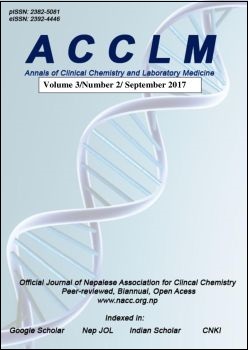Influenza: An Emerging and Re-emerging Public Health Threat in Nepal
DOI:
https://doi.org/10.3126/acclm.v3i2.20737Keywords:
Influenza, virusAbstract
Influenza virus type A and B are responsible for seasonal epidemics as well as pandemics in human. Influenza A viruses are further divided into two major groups namely, low pathogenic seasonal influenza (A/H1N1, A/H1N1 pdm09, A/H3N2) and highly pathogenic influenza virus (H5N1, H5N6, H7N9) on the basis of two surface antigens: hemagglutinin (HA) and neuraminidase (NA). Mutations, including substitutions, deletions, and insertions, are one of the most important mechanisms for producing new variant of influenza viruses. During the last 30 years; more than 50 viral threat has been evolved in South-East Asian countriesof them influenza is one of the major emerging and re-emerging infectious diseases of global concern. Similar to tropical and sub-tropical countries of Southeast Asia; circulation of A/H1N1 pdm09, A/H3N2 and influenza B has been circulating throughout the year with the peak during July-November in Nepal. However; the rate of infection transmission reach peak during the post-rain and winter season of Nepal.
Downloads
Downloads
Published
How to Cite
Issue
Section
License
Authors who publish with this journal agree to the following terms:
- The author transfers copyright to the Nepalese Association for Clinical Chemistry.
- The journal publishes the work under a Creative Commons Attribution License that allows others to share the work with an acknowledgement of the work's authorship and initial publication in this journal and under the same share-alike license used here.
- Authors are able to enter into separate, additional contractual arrangements for the non-exclusive distribution of the journal's published version of the work (e.g., post it to an institutional repository or publish it in a book), with an acknowledgement of its initial publication in this journal.
- Authors are permitted and encouraged to post their work online (e.g., in institutional repositories or on their website) prior to and during the submission process, as it can lead to productive exchanges, as well as earlier and greater citation of published work (See The Effect of Open Access).




